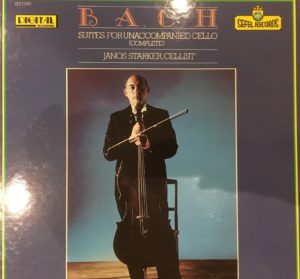

Janos Starker Bach Cello Suites Sefel Records SEFD300 3LP box set.
Date of release, 1984. Recording venue is the Musical Arts Center Indiana University School of music. No specification of recording dates nor cello played.
Introduction.
This release intrigues me. It is unknown to many and very hard to come by. It is available on CD but Music discogs list only one volume covering Suites 1,2 and 3.
For me, the intrigue comes from the use of the Soundstream Digital recording process. The scan above shows the page in the booklet that dwells on this matter.
For more information check out this link.
Sefel appears to have been a Canadian record label active mainly between 1980 and 1987.
Janos Starker needs no introduction and his Mercury Living Prescence recordings of the Suites are probably the most recommended (despite some deficiencies!). The Sefel recording is the 4th of 5 that Starker recorded.
In the booklet Starker gives an interesting personal look back at his recordings of the Suites. It fascinates me that he cannot recall the reason why the first recording made for Period omitted Suites 2 and 5. He suggests it might have been a financial or time issue.
The Recording.
At initial listen, this recording does not impress purely in terms of recording quality. The sound is veiled and lacks obvious top end. My initial analysis is of a mid and low frequency fullness. With a bit of experimentation with speaker placement, further away from walls this improves. The treble is still lacking. However, very low noise level and a smoothness and sweetness of the upper registers at least partially compensate. This is particularly welcome when one recalls some of the unpleasant sounds emanating from even newer recordings especially on CD. No other vinyl recording in my collection of the Suites has quite the same smoothness and lack of fatigue on prolonged listening. That includes the latest Analogue Productions release of the Mercury Living Prescence recording on 45 rpm!
Although I can understand how the Red book CD overtook this digital system, it’s a pity we tolerated the glassiness of CD for so long!
The Music.
We have reviews of the third and fifth recordings on this site. In general, the third impresses as a technical tour de force, musical but very business-like. The fifth recording for RCA is more laid back, with slower tempos, more variety in phrasing and dynamics and more flexing of timing.
Both are clearly mainstream recordings with legato phrasing displaying vibrato at all times.
It will be no surprise to the reader for me to advise that this fourth recording lies somewhere in between the two! To my ears, it’s the perfect compromise of tempos and phrasing. Then there is the bonus of rhythmicity missing from the third recording. This is a reminder that after the Preludes these are dance movements. My foot taps away most of the time with this recording. Brisker pace preserves the momentum and pulse of the music, in contrast to the fifth 1992 recording.
Which cello?
As previously suggested, a further bonus is the smooth and silky sound of the cello. By 1984 Starker had moved on from his Stradivarius and used a Goffriller. Whether the instrument Starker plays here is the Goffriller or a Guarnerius which he was also known to possess, I cannot ascertain. However, other cellists including Winona Zelenka who recorded the Suites on the same Guarnerius produce a lovely resonant sound reminiscent of what I hear on this recording. It is also noticeable that Starker appears to be playing less forcefully and with more subtlety here. It is as if he is playing in a small chamber recital as opposed to a large concert hall.
Just one specific quirk that I noted was in the third Suite Allemande. Here, Starker introduces ornamentation which is used very little elsewhere and in the same lines little portamenti. Very incongruous but I’m sure their inclusion was very considered!
Conclusion.
I would have to say this is my favourite Starker version of the Bach Cello Suites. This, for its musicality, cello sound and relaxed listening experience. It’s a great shame it is not more widely available. If the original masters are available, I’m sure it would benefit from some subtle remastering to address the points I made above and handsomely repay in sales the costs incurred.
Charles.